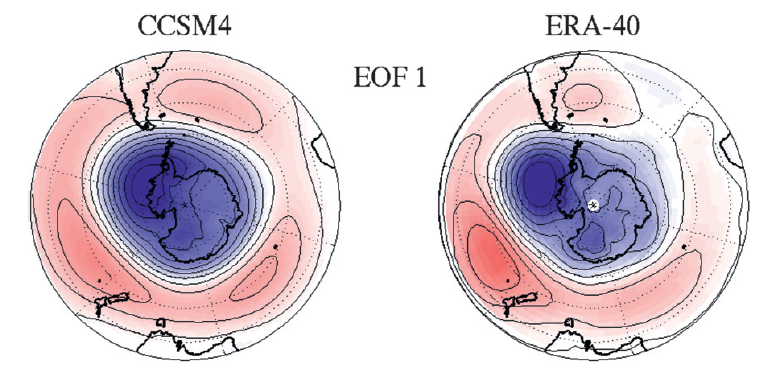Southern Ocean
The high latitudes are regions of extremes. The interactions between the ocean, atmosphere, cryosphere and marine ecosystems are intense, but greatly influence the global climate system. Our HiLAT-RASM project aims to understand these interactions and feedbacks, and the associated impacts on the climate system.

A faithful representation of these processes in coupled climate models is therefore essential for reliable climate projections. In Weijer et al. (2012) we studied several aspects of the Southern Ocean in the Community Climate System Model version 4 (CCSM4), addressing topics like the surface climatology and its interannual variability, the representation of water masses, the structure of the Antarctic Circumpolar Current, and interocean exchanges. I co-edited a special issue of Deep Sea Research II focusing on Southern Ocean dynamics and biogeochemistry in a changing climate (Downes et al. 2015).
Dynamically, the Southern Ocean is unique in the fact that it lacks continental boundaries at a range of latitudes. This has important implications for the dynamics that govern the ocean circulation there. In collaboration with Sarah Gille at Scripps Institution of Oceanography, I studied the response of the Southern Ocean to high-frequency (order days to weeks) variability of Southern Ocean winds. I forced the MITgcm with stochastic winds, and found that the response was dominated by barotropic modes (Weijer 2005; Weijer and Gille 2005a). The so-called Southern Mode (Hughes et al., 1999) was found to account for a "reddening" of the spectrum (since it is a non-oscillatory mode), while several topographic modes gave rise to resonant peaks. The resonance yielded an interesting coherence between zonal transport and wind stress for periods below about a week. The decay of these modes appeared to be controlled by circulation/bathymetry interaction, independent of frictional parameters. However, friction obviously plays a crucial role in the energy balance. In Weijer and Gille (2005b) we explored the energy flow from power input by the wind stress to the dissipation by frictional effects in more detail.
In a recent project, I collaborated with scientists from Princeton University and GFDL to explore the upwelling pathways of deep water in the Southern Ocean. In Tamsitt et al. (2017) we performed Lagrangian analysis on particles that flowed into the Southern Ocean at depth, and found that they undergo a spiraling motion, as they gradually upwell around Antarctica, while being swept around by the Antarctic Circumpolar Current.
Finally, we have a strong interest in Southern Ocean polynyas. We are very interested in the impact of the associated heat exchange on the ocean and atmosphere. In Weijer et al. (2017) we studied the atmospheric response to polynyas in an eddy-resolving ocean model. In two studies by Prajvala Kurtakoti we studied the formation of Maud Rise and Weddell Sea Polynyas (Kurtakoti et al. 2018, Kurtakoti et al. 2021), while Kaufman et al. (2020) studied the causal relationships between oceanic and atmospheric variables in the context of polynyas.
References
- Downes et al. 2015: Southern Ocean dynamics and biogeochemistry in a changing climate: Introduction and overview. Deep-Sea Res. II: Top. Stud. Oceanogr., 114, 1-2. doi: 10.1016/j.dsr2.2015.02.013.
- Hughes et al. 1999: Wind-driven transport fluctuations through Drake Passage: a Southern Mode. J. Phys. Oceanogr., 29, 1971-1992.
- Kaufman et al. 2020: Causal interactions between Southern Ocean polynyas and high-latitude atmosphere-ocean variability. J. Clim., 33, 4891-4905, doi:10.1175/JCLI-D-19-0525.1.
- Kurtakoti et al. 2021: On the Generation of Weddell Sea Polynyas in a High-Resolution Earth System Model. J. Clim., 34, 2491-2510, doi:10.1175/JCLI-D-20-0229.1.
- Kurtakoti et al. 2018: Preconditioning and Formation of Maud Rise Polynyas in a High-Resolution Earth System Model. J. Clim., 31, 9659-9678, doi: 10.1175/jcli-d-18-0392.1.
- Tamsitt et al. 2017: Spiraling pathways of global deep waters to the surface of the Southern Ocean. Nat. Comm. 8, 172, doi:10.1038/s41467-017-00197-0.
- Weijer 2005: High-frequency wind forcing of a channel model of the ACC: Normal mode excitation. Ocean Model., 9, 31-50, doi: 10.1016/j.ocemod.2004.04.001.
- Weijer and Gille 2005a: Adjustment of the Southern Ocean to wind forcing on synoptic time scales. J. Phys. Oceanogr., 35, 2076-2089, doi: 10.1175/jpo2801.1.
- Weijer and Gille 2005b: Energetics of wind-driven barotropic variability in the Southern Ocean. J. Mar. Res., 63, 1101-1125, doi: 10.1357/002224005775247562.
- Weijer et al. 2012: The Southern Ocean and its Climate in CCSM4. J. Clim., 25, 2652-2675, doi: 10.1175/jcli-d-11-00302.1.
- Weijer et al. 2017: Local atmospheric response to an open-ocean polynya in a high-resolution climate model. J. Clim., 30, 1629-1641, doi: 10.1175/jcli-d-16-0120.1.


